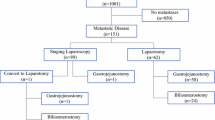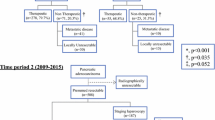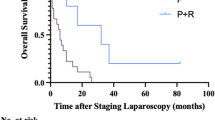Abstract
Background:Patients with potentially resectable hepatobiliary malignancy are frequently found to have unresectable tumors at laparotomy. We prospectively evaluated staging laparoscopy in patients with resectable disease on preoperative imaging.
Methods:Staging laparoscopy was performed on 410 patients with potentially resectable hepatobiliary malignancy. The preoperative likelihood of resectability was recorded. Data on preoperative imaging, operative findings, and hospital course were analyzed.
Results:Laparoscopic inspection was complete in 291 (73%) patients. In total, 153 patients (38%) had unresectable disease, 84 of whom were identified laparoscopically, increasing resectability from 62% to 78%. On multivariate analysis, a complete examination, preoperative likelihood of resection, and primary diagnosis were significant predictors of identifying unresectable disease at laparoscopy. The highest yield was for biliary cancers, and the lowest was for metastatic colorectal cancer. In patients with unresectable disease identified at laparoscopy, the mean hospital stay was 3 days, and postoperative morbidity was 9%, compared with 8 days and 27%, respectively, in patients found to have unresectable disease at laparotomy.
Conclusions:Laparoscopy spared one in five patients a laparotomy while reducing hospital stay and morbidity. Targeting laparoscopy to patients at high risk for unresectable disease requires consideration of disease-specific factors; however, the surgeons’ preoperative impression of resectability is also important.
Similar content being viewed by others
REFERENCES
Bartlett DL, Fong Y, Fortner JG, Brennan MF, Blumgart LH. Long-term results after resection for gallbladder cancer. Implications for staging and management. Ann Surg 1996; 224: 639–46.
Jarnagin WR, Fong Y, DeMatteo RP, et al. Staging, resectability, and outcome in 225 patients with hilar cholangiocarcinoma. Ann Surg 2001; 234: 507–17.
D’Angelica M, Brennan MF, Fortner JG, Cohen AM, Blumgart LH, Fong Y. Ninety-six five-year survivors after liver resection for metastatic colorectal cancer. J Am Coll Surg 1997; 185: 554–9.
Fong Y, Sun RL, Jarnagin W, Blumgart LH. An analysis of 412 cases of hepatocellular carcinoma at a Western center. Ann Surg 1999; 229: 790–9.
Harrison LE, Brennan MF, Newman E, et al. Hepatic resection for noncolorectal, nonneuroendocrine metastases: a fifteen-year experience with ninety-six patients. Surgery 1997; 121: 625–32.
Scheele J, Stang R, Altendorf-Hofmann A, Paul M. Resection of colorectal liver metastases. World J Surg 1995; 19: 59–71.
Weber SM, Jarnagin WR, Klimstra D, DeMatteo RP, Fong Y, Blumgart LH. Intrahepatic cholangiocarcinoma: resectability, recurrence pattern, and outcomes. J Am Coll Surg 2001; 193: 384–91.
Velanovich V, Wollner I, Ajlouni M. Staging laparoscopy promotes increased utilization of postoperative therapy for unresectable intra-abdominal malignancies. J Gastrointest Surg 2000; 4: 542–6.
Conlon KC, Dougherty E, Klimstra DS, Coit DG, Turnbull AD, Brennan MF. The value of minimal access surgery in the staging of patients with potentially resectable peripancreatic malignancy. Ann Surg 1996; 223: 134–40.
Burke EC, Karpeh MS, Conlon KC, Brennan MF. Laparoscopy in the management of gastric adenocarcinoma. Ann Surg 1997; 225: 262–7.
Jarnagin WR, Bodniewicz J, Dougherty E, Conlon K, Blumgart LH, Fong Y. A prospective analysis of staging laparoscopy in patients with primary and secondary hepatobiliary malignancies. J Gastrointest Surg 2000; 4: 34–43.
John TG, Greig JD, Crosbie JL, Miles WF, Garden OJ. Superior staging of liver tumors with laparoscopy and laparoscopic ultrasound. Ann Surg 1994; 220: 711–9.
Babineau TJ, Lewis WD, Jenkins RL, Bleday R, Steele GD Jr, Forse RA. Role of staging laparoscopy in the treatment of hepatic malignancy. Am J Surg 1994; 167: 151–4.
Lo CM, Lai EC, Liu CL, Fan ST, Wong J. Laparoscopy and laparoscopic ultrasonography avoid exploratory laparotomy in patients with hepatocellular carcinoma. Ann Surg 1998; 227: 527–32.
Jarnagin WR, Conlon K, Bodniewicz J, et al. A clinical scoring system predicts the yield of diagnostic laparoscopy in patients with potentially resectable hepatic colorectal metastases. Cancer 2001; 91: 1121–8.
Rahusen FD, Cuesta MA, Borgstein PJ, et al. Selection of patients for resection of colorectal metastases to the liver using diagnostic laparoscopy and laparoscopic ultrasonography. Ann Surg 1999; 230: 31–7.
Weber SM, DeMatteo RP, Fong Y, Blumgart LH, Jarnagin WR. Staging laparoscopy in patients with extrahepatic biliary carcinoma. Analysis of 100 patients. Ann Surg 2002; 235: 392–9.
D’Angelica M, Jarnagin WR, DeMatteo RP, Conlon KC, Blumgart LH, Fong Y. Staging laparoscopy for potentially resectable noncolorectal, nonneuroendocrine liver metastases. Ann Surg Oncol 2002; 9: 204–9.
Burke EC, Jarnagin WR, Hochwald SN, Pisters PW, Fong Y, Blumgart LH. Hilar cholangiocarcinoma: patterns of spread, the importance of hepatic resection for curative operation, and a presurgical clinical staging system. Ann Surg 1998; 228: 385–94.
Jimenez RE, Warshaw AL, Rattner DW, Willett CG, McGrath D, Fernandez-del Castillo C. Impact of laparoscopic staging in the treatment of pancreatic cancer. Arch Surg 2000; 135: 409–14.
Espat NJ, Brennan MF, Conlon KC. Patients with laparoscopically staged unresectable pancreatic adenocarcinoma do not require subsequent surgical biliary or gastric bypass. J Am Coll Surg 1999; 188: 649–55.
Minnard EA, Conlon KC, Hoos A, Dougherty EC, Hann LE, Brennan MF. Laparoscopic ultrasound enhances standard laparoscopy in the staging of pancreatic cancer. Ann Surg 1998; 228: 182–7.
Foroutani A, Garland AM, Berber E, et al. Laparoscopic ultrasound vs triphasic computed tomography for detecting liver tumors. Arch Surg 2000; 135: 933–8.
Van Beers BE, Gallez B, Pringot J. Contrast-enhanced MR imaging of the liver. Radiology 1997; 203: 297–306.
Arulampalam T, Costa D, Visvikis D, Boulos P, Taylor I, Ell P. The impact of FDG-PET on the management algorithm for recurrent colorectal cancer. Eur J Nucl Med 2001; 28: 1758–65.
Author information
Authors and Affiliations
Corresponding author
Rights and permissions
About this article
Cite this article
D’Angelica, M., Fong, Y., Weber, S. et al. The Role of Staging Laparoscopy in Hepatobiliary Malignancy: Prospective Analysis of 401 Cases. Ann Surg Oncol 10, 183–189 (2003). https://doi.org/10.1245/ASO.2003.03.091
Received:
Accepted:
Issue Date:
DOI: https://doi.org/10.1245/ASO.2003.03.091




